Building Strong Teeth for Life

Many people take vitamins, exercise and eat right to maintain a healthy body. However, what about your teeth? They need tender loving care to stay healthy and strong as well. Most people either don’t realize how much care they need to give their teeth, or they forget because of busy schedules. However, building strong teeth for life only takes a few minutes of your day to achieve. Your teeth need daily brushing, flossing and other care to keep them free of damaging substances. You also need dental appointments, oral cancer screenings, a healthy diet and more to avoid tooth loss and oral health problems. Follow these simple guidelines to keep your smile healthy for life!
How Strong Are Teeth?
Many people simply assume that the teeth are bones, but they actually are not. Your bones and your teeth are some of the hardest tissues in your body and are made of calcium and phosphate. However, your teeth are actually harder. Bones have spongy insides, but teeth are 96% hard mineral. That’s why you can exert up to 200 pounds of pressure when you chew according to the ADA. However, no matter how strong teeth are, they can’t repair themselves when they become damaged.
What Weakens Teeth
Your teeth are some of the strongest parts of your body, but even the strongest materials can become weak over time. Generally, poor oral hygiene habits are what weaken your teeth the most. Genetics can give some patients weak enamel, but 99% of the time the problem is your hygiene. Tooth decay is so common among American children and adults, that the National Institutes of Health consider it to be the most “prevalent chronic disease” around. You get this disease by simply not brushing and flossing enough. Sugar plus saliva makes plaque, and that plaque sticks to your teeth and decays them. People who don’t brush or floss their teeth can expect to have problems with tooth decay, bad breath, gum disease, tooth loss and more. Bottom line: brush your teeth and do it every day!

Building Strong Teeth Through Nutrition
Too often, the American diet consists of quick foods that generally are low in nutrition and high in sugar. If you look at the labels of most of these foods, you will find that ½ or more of many pre-packaged snacks are pure sugar. Even “healthy” or diet foods can be terrible for both your body and your teeth because of that sugar factor. Foods that have an unexpectedly high amount of sugar include:
- Yogurt
- Breads (rolls, pastries, doughnuts, sandwich bread, etc.)
- Cereal (including oatmeal)
- Drinks
- Protein bars
- Pancakes and similar breakfast items
- Many dressings and sauces
- Fruit snacks or dried fruit
A person can drink 3 candy bars’ worth of sugar in a single soda without realizing it. That’s why it’s always important to check labels and choose foods free of sugar or very low in sugar. Not only with that sugar rot your teeth, but it will cause you health problems.
Instead of sugary foods, choose nutritious foods such as:
- Low or zero sugar yogurt. These are high in calcium.
- Dairy products such as cheese and milk. Dairy contains high amounts of calcium, proteins and other minerals for building strong teeth.
- Water. Sports drinks, sodas and juices are full of sugar.
- Crunchy, high-fiber foods. Celery, carrots, and apples are some of these foods that can help scrape particles off your teeth as you eat them.
- Leafy greens. These are full of so many vitamins that they can significantly help your oral health and overall wellness.
Also avoid tobacco use, as tobacco quickly damages teeth and causes oral cancer.
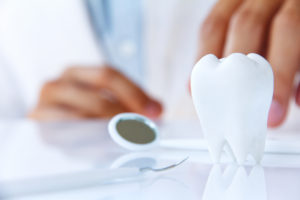
Essential Oral Hygiene Habits
You need to eat well to have strong teeth, but you also need to be cleaning your teeth meticulously. Every person must brush and floss their teeth or they will get tooth decay. It’s inevitable without those basic oral hygiene habits. The American Dental Association recommends brushing the teeth at least twice a day to keep them free of plaque. If you brush your teeth after every meal and teach children to do the same, the risk of tooth decay goes down even more. Adding fluoride to your hygiene routine makes teeth stronger, as this mineral provides a shield for your tooth enamel against sugars, acids and other harmful substances. When choosing toothpastes, mouthwashes and more, look for products with fluoride in them.
Flossing is often overlooked by many people, but it too is essential to keeping your teeth strong, especially with braces. Food and drink pass through your teeth everyday. When you chew, food is lodged in cracks with every bite. You can clean your teeth front and back, but don’t forget about the spaces in between. Flossing dislodges food that would otherwise decay and weaken tooth enamel. If patients floss all the way up in their gum line on both sides of each individual tooth, they remove hidden plaque that causes gum problems. Using floss to scrape down the teeth as you go is a great way to remove anything that coats the tooth surface. If you don’t do anything else, make sure you and your children at least follow these basic oral hygiene habits. To learn about more oral hygiene habits you need (like visiting the dentist), call Belmar Orthodontics today at (303) 225-9016!
Teaching Children Good Oral Hygiene Habits

If you teach a child good oral hygiene habits early on, odds are that they will have better oral hygiene habits when they are teens and adults. As soon as a toddler gets their first tooth, it’s essential to start brushing and flossing their teeth. Afterwards, you will need to teach them the basics of good oral hygiene practices, especially when it comes to wearing braces. Find out what those basics are and what you should be thinking about for your child’s oral health!
Teaching Good Oral Hygiene Early
Good oral hygiene habits are essential for a healthy mouth and especially during orthodontic care. Many children need early orthodontics, which is also known as “child orthodontics”. This is when bite and alignment issues are corrected around age 7 or 8 to avoid serious problems later on. However, we hope that every child has good oral hygiene habits established well before this visit. Otherwise, not only will a child be dealing with bite and alignment issues, but they will also be dealing with tooth decay.
As soon as your child gets their first tooth as a baby, you need to start brushing that tooth. Brush it morning and night with a rice-size amount of fluoride toothpaste. Also make sure to clean your baby’s gums with a wet cloth after feedings. Once they start to grow, begin teaching them how to brush their teeth properly. You will have to help brush your child’s teeth for the first couple of years until they have the dexterity in their hands to do it themselves. Flossing will come later as more teeth come in.

Learning to Brush
Brushing the teeth is one of the most important habits a child can have. Brushing long enough is key for a healthy mouth. Make sure you get a toothbrush that fits the size of your child’s mouth. There are brushes for infants, toddlers, children, teens and adults. All will be different sizes and some children brushes will come in fun shapes and colors to help children brush.
Children can’t always tell how long they have been brushing. Having them brush their teeth for a duration of a song or brushing your teeth alongside them to make sure they brush long enough. When they are old enough to have braces, brushing is even more important than before to avoid tooth decay. Food that gets stuck in brackets can cause rapid decay. Make sure they brush longer and at different angles to dislodge food. When children are first learning, brush with them as many days as it takes when first learning to brush their teeth. Do the same when they learn to brush with braces.
Flossing 101
Children won’t have to floss until they are toddlers. The baby teeth are spaced out until they all come in. Kids will have a total of 20 baby teeth that will start to come closer together as a baby ages. Until a child has the dexterity to use floss like an adult, it’s smart to invest in flossers. These are secure, hand-held flossing tools that children can put in between their teeth to easily dislodge food. Ask us about mouthwash and fluoride products to see if they should be part of your child’s oral hygiene routine as well.
See a Dentist and Orthodontist
Starting from an early age, children need to start visiting the dentist. By age 7, they should see us for an orthodontic exam as well. Dental visits themselves are so important that most dental insurances cover those twice-a-year visits. These biannual visits generally consist of comprehensive exams and dental cleanings. At first, children may be nervous about visiting a dentist. Offices can be large with busy equipment that children aren’t familiar with. Dental tools can also be loud, which can make children nervous. However, these visits are nothing to worry about whether it is a dentist or orthodontist.
To help your child get used to being in an office, make sure you go to a pediatric dentist instead of a general dentist while they are young. Pediatric offices (such as our orthodontic one) has staff that is trained to work well with children. Dr. Hardyl has experience with children on a daily basis. He was trained in both dentistry and orthodontics and can spot the signs of dental issues early-on. His staff knows what kids worry about and they know how to explain dental and orthodontic terms so a child can understand. An exam sounds serious, but it’s really just Dr. Hardy looking inside your child’s mouth for any bite, alignment or dental problems. If a child hasn’t seen Dr. Hardy by age 7, make sure to get them in for an examination!
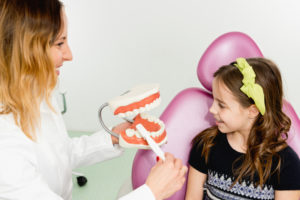
Good Habits for Life
Start children out young when teaching them good oral hygiene. If you make a habit of brushing and flossing, children will see that example and will follow it. When you help them learn good oral hygiene habits as soon as they can talk and understand, they can start keeping their mouth clean themselves. There are many resources online to help teach children specifics of brushing, flossing, and for learning about dental hygiene. We help children every day with brushing, flossing, caring for braces and establishing good oral hygiene. Call Belmar Orthodontics at (303) 225-9016 with any and all questions you have about your child’s oral health. Let us help you as you and your child learn to establish good oral hygiene habits together!
A Straight Smile for Life with Retainers
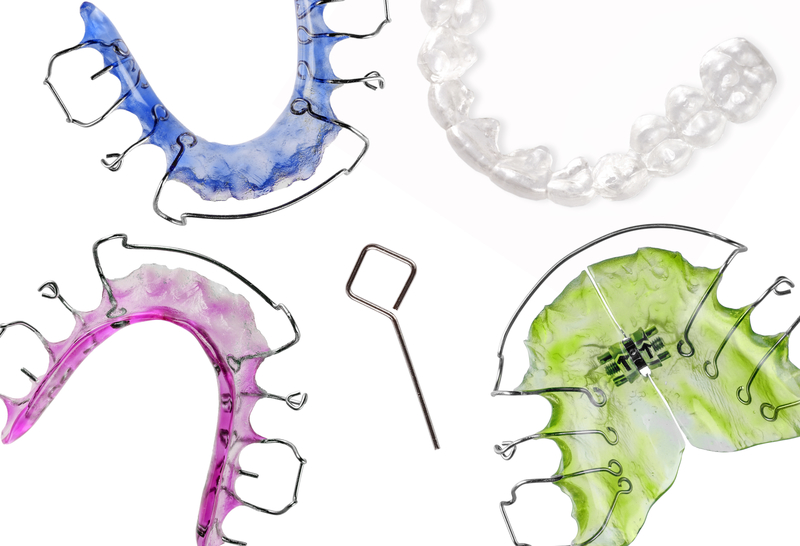
Most patients spend 18-24 months with their orthodontic appliances. That’s about 78-104 weeks of your life with braces, and time that you don’t want to have wasted. The worst thing that can happen after getting your braces off is that your teeth go crooked once more. This can happen within the first month if you’re not careful. Luckily, dentists know this and we provide our patients with either removable retainers or permanent ones. See why retainers are so important for maintaining a straight smile for life and why you need one!
Finishing Up with Braces
If you have gotten to the point in your orthodontic treatment that you need a retainer, congratulations! It has taken you 18-24 months to get that beautiful, straight smile you’ve wanted. No matter if you had lingual, ceramic, or metal braces, or if you opted for Invisalign treatment, you will still need an orthodontic appliance to keep your teeth straight. This isn’t something you want to wait on either, as studies show that your teeth start shifting back to their crooked state within the first month of getting braces off.
When our patients end their time with braces, we immediately prep them for either a removable or a permanent retainer. There are pros and cons to each of these types of retainers, but the bottom line is, you need one! A retainer is exactly what it sounds like; it “retains” your straight smile. When you wear it (usually at night), your smile won’t shift or become crooked. We take an impression of your teeth as soon as your braces come off, which we then send to our lab. You will have a retainer custom-made to fit your newly-straightened teeth that will keep them in that position for decades to come.

Retainers 101
You may need both a bottom retainer and a top one, or you might just need one. Some dentists only require a bottom retainer, as the bottom teeth tend to keep the top teeth in place. It all depends on the patient. As we mentioned, there are two types of retainers: removable and permanent.
- Removable – These are the classic retainer pieces that most people think of when they think “retainer”. When we make impressions of your teeth, we go back and use those impressions to make retainer pieces for your top and bottom jaw. Once they are done, you will come into the office and try out your new retainers. Wear them every day during the night and clean them when you take them out in the morning. Only use cleaning products that are safe for mouth retainers and never use hot water when cleaning.
- Permanent – This is also a “fixed” retainer because it is bonded to your teeth and set in place. Much like your braces (if you chose ceramic, lingual or traditional metal), we will bond metal parts to your teeth. However, these metal parts will be placed on the back of your teeth instead of the front. You can choose to have a metal bar that goes across the back teeth or you can choose small metal wires that will bond each individual tooth to the one next to it. If you choose the second, you will have the bottom 6 teeth connected, with bonding cement on each of the backs of those 6 teeth. However, the metal and bonding is small, so it won’t take up very much room in your mouth. You may not even notice it! Both the bar and series of small wires work to keep your bottom teeth in place, which will keep your top in place.
Which One Is Right for You?
Our patients can choose if they want to have a removable or permanent retainer. One might not be right for a patient depending on age and daily habits. If you often lose things (such as car keys or your phone), then you might want to choose a permanent retainer. These stay in place 100% of the time and because of that, you can never lose them. Plus, they retain your teeth around the clock, instead of only at night (like a removable retainer). Permanent retainers also aren’t visible like removable retainers are because they are attached behind your teeth.
A removable retainer will have visible bars that others will be able to see in your mouth when you show your teeth. This generally isn’t a problem, as most people wear theirs at night. If you already struggle with brushing and flossing your teeth, you might opt for a removable retainer, as flossing can be more difficult with a permanent retainer. However, both options are great for all our patients. You simply have to choose which one fits you best.

Healthy Life, Healthy Mouth
We would love every single one of our patients to have a straight smile many decades from now. If you wear your retainer like you should, or continually renew your permanent ones, you can count on keeping that straight smile. However, you also want to keep your smile healthy and free of disease throughout all those decades. After all, there is no point in striving for a straight smile if you don’t have any teeth!
No matter if you are 9 or 90, you have to keep up on proper oral hygiene practices if you want to have a healthy, beautiful smile. Brush and floss your teeth every single day, making sure to brush multiple times a day. Eat nutritious foods and cut down on the sugar to reduce your risk for tooth decay and gum disease. Also, clean your retainer every day so that it stays strong and durable for many years. If you need a new retainer, or are interested in a permanent retainer option, call Belmar Orthodontics today at (303) 225-9016!
Dental Care during Braces
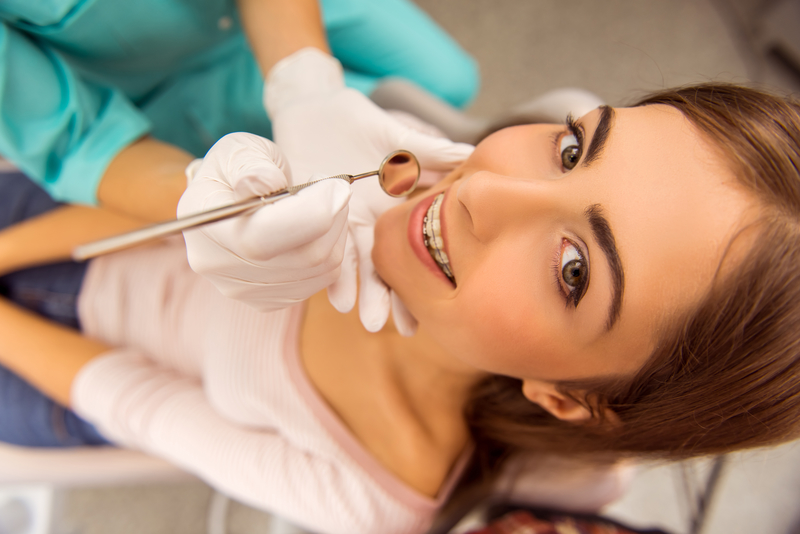
An orthodontist has been to dental school and is skilled enough to spot gum and teeth problems. However, seeing an orthodontist is not enough to keep your teeth healthy. During your time receiving braces, it’s also important to keep seeing a dentist for cleanings, exams and dental treatments. Learn why dental care and oral hygiene is important during your time with braces and how it can help you have a better smile after your braces!
Caring for Metal Braces
Your dental care during braces will depend on the type of braces you receive. If you choose metal braces, brackets and wires in your mouth make it easier for food particles to get stuck. This quickly leads to dental issues if proper care is not taken. You have to be meticulous about cleaning away plaque and stuck food particles so that you avoid tooth decay and demineralization of your tooth enamel. You do this by:
- Brushing after every meal. Your braces easily trap food particles every single time you eat. Brushing after each meal can prevent staining and reduce the potential for bacteria buildup. When brushing, make sure you have a regular, soft-bristle brush. Brush down from the top, then up from the bottom on each tooth that has a bracket.
- Using a threadable floss or floss threader. You will quickly notice that you can’t floss the conventional way with metal braces because the archwire is in the way. If you use a floss threader, thread regular floss through the eye of the threader like you would a sewing needle and thread. Or, using threadable floss, insert the small or pointed end in between your teeth, pulling it through. Once in place between your teeth, you can floss the two teeth on either side of where you have inserted the floss, taking care not to apply force or pressure against the archwire. Repeat between all teeth.
- Using a proxabrush. This is a small brush that looks like a Christmas tree. Place the proxabrush between two brackets, below the archwire, brushing up and down. After several strokes, repeat this motion by inserting the brush from the opposite side (either down from the top or up from the bottom).
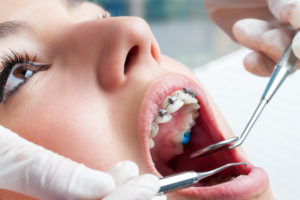
Dental Care with Other Braces
There are other types of braces besides metal braces. At our office, we also offer Invisalign, lingual braces and ceramic braces.
- Ceramic braces – Care for ceramic braces is the same as for traditional metal braces. This is because the design of these braces are the exact same, except they are made out of white, ceramic material.
- Lingual braces – These braces consist of brackets and wires that are placed on the tongue-side of your teeth (meaning behind the teeth). You will have to be more careful with brushing and flossing your teeth, as you won’t be able to see the brackets and wires as well. However, cleaning is very similar to how you would clean metal braces. With flossing, floss threaders will become your best friend, and you’ll want to be meticulous with this because food can get stuck more often with the braces being inside your mouth by your tongue.
- Invisalign – This orthodontic appliance is completely different than the other options you have. Invisalign is a series of transparent aligners that you switch out every week. The benefit of these aligners is that you can easily remove them, and brush and floss your teeth like normal. No brackets, wires or lengthy flossing session. When you take the aligners out, rinse them to get the saliva off of them. Then soak them in a retainer/braces cleaner. An example is Retainer Brite or denture cleaner.
Do You Need to See a Dentist?
Did you know that an orthodontist must complete dental school. In order to practice orthodontics, they need to complete a 4-year bachelor’s degree followed by 4 years of dental school. After that time, an orthodontist will continue 2-3 years of additional training and schooling to practice orthodontics. Therefore, an orthodontist knows what a dentist knows when it comes to your oral health. However, one point that we want to stress is that you need to continue seeing the dentist during your time with braces.
An orthodontist is skilled at treating issues with your oral health, however, an orthodontist is in charge of correcting bite and alignment. A dentist is the one that will need to correct problems with tooth decay and gum disease. Even though an orthodontist has received the same training, their profession is to not to fill cavities or do root canals unless their practice does both. During your time with braces, you must continue receiving dental care from a dentist. Braces raise your risk for tooth decay and gum disease
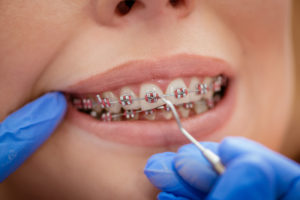
Dental Care during Your Time with Braces
Your dental care during braces will depend on the type of braces you receive. Many patients choose traditional metal braces for straightening their teeth. No matter what orthodontic option you choose, it is particularly important to maintain great dental care through attention to proper oral hygiene. If you don’t know what that proper hygiene routine looks like, we can help you. As always, if you have any questions about braces care or maintenance, please do not hesitate to contact our office. We are here to help you reach your goals and to keep your mouth healthy. For help caring for your braces, or if you are finding certain oral hygiene tasks difficult, call Belmar Orthodontics at (303) 225-9016!
Are Your Teeth Cleaning Habits Good Enough?
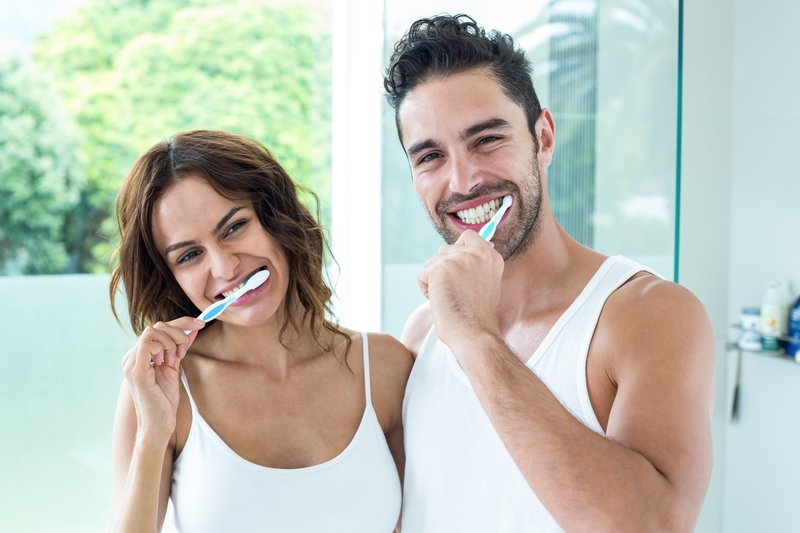
Braces can keep your teeth straighter, making them more beautiful and attractive. However, if your teeth cleaning habits are poor, your smile will take a hit. How well you take care of your teeth before and during braces will be an indication of how your smile will be after your orthodontic care has come to an end. If you don’t brush and floss the teeth enough, you might damage your smile and weaken your enamel. You must step up your cleaning routine during braces to make sure your smile isn’t full of cavities and oral health problems at the end of your care. We can give you the proper recommendations and guidelines to ensure you keep your smile healthy and strong during your time with braces and throughout life.
Brushing With and Without Braces
The American Dental Association recommends brushing and flossing the teeth at least twice a day to keep your mouth healthy and to lower your risk for tooth decay and gum disease. We go beyond that twice-a-day recommendation and suggest that you brush your teeth after every meal. Because your braces can easily attract and trap food particles, brushing after each meal can help prevent staining and reduce the potential for bacteria buildup.
You should use a soft-bristled brush and use one that’s size fits your mouth well. For teeth without braces, the ADA recommends brushing the teeth at a 45 degree angle. Brush each individual tooth, making sure to go all the way up to the gumline. You use a soft-bristled brush to avoid irritating the gums and eroding your tooth enamel. With braces, you want to brush down from the top, then up from the bottom on each tooth with a bracket. This will help dislodge food particles that have become trapped inside the brackets, which is extremely easy to do. Brushing your teeth multiple times a day is one of the best cleaning habits for avoiding decay.
Flossing the Teeth
We recommend flossing your teeth at least once a day. However, that’s for patients that don’t have braces. When you have braces, it’s even more important to floss each and every tooth. It’s also much more time consuming, but the effort you put into your teeth cleaning habits will pay off in the long run. A toothbrush and mouthwash simply can’t get in between the teeth like floss can, so if you skip flossing, you could have food sit and decay your teeth.
You will have to use threadable floss or a floss threader to accomplish this feat with brackets. If you use a floss threader for your teeth, think of your cleaning habits like you’re sewing. You floss the eye of the threader through your teeth and below the archwire. Then you floss the space, pull it out and thread once more. Make sure you don’t apply force or pressure against the archwire as you do this. For some patients, it may take about 10 minutes to floss, but it’s worth taking the time to avoid tooth decay.
Caring for Braces
Caring for your teeth becomes trickier with braces. You will find that you have to devote some extra time to caring for your braces, as you know have about 32 teeth that all have brackets that can collect food. During your time with braces, it is particularly important to maintain good oral health through attention to proper oral hygiene and cleaning habits. If you don’t, you could have your braces removed only to find that many of your teeth have areas of tooth decay. You could also be left with demineralization that leaves marks on all your teeth where the brackets were.
When it comes to caring for your braces, it’s not only important to clear away food particles that are on the teeth, but to be careful of what foods you put into your mouth. To avoid damage to your braces and your teeth during orthodontic treatment, you want to avoid hard foods, sticky foods, and foods high in sugar. This means you should avoid eating foods such as hard candy, chips, ice, apples, nuts, popcorn, carrots, corn on the cob, gum, caramel, taffy, licorice, gummies, and similar foods. Prevention is always key for avoid oral health issues!
Proper Teeth Cleaning Habits
If you’re going to spend 18-24 months straightening your teeth, you might as well keep those teeth healthy so they look nice at the end of your treatment. Brush your teeth every single day, multiple times a day. Floss as well and be meticulous with your cleaning habits. The better care you take of your braces while they’re on, the more you’ll enjoy your smile when they come off. If you would like help with your cleaning habits or tips, call our Belmar Orthodontics office today at (303) 225-9016!

